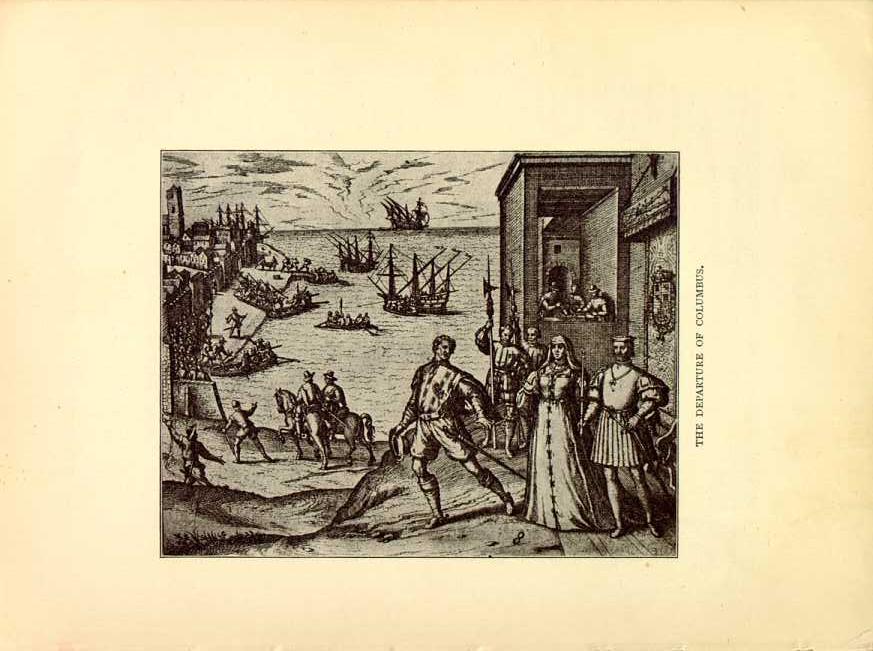| Colonial Children | ||
1. PART I
DISCOVERY OF AMERICA
1. Saga of a Wineland Baby[1]
BY HAUK ERLENDSSON (ABOUT 1000)
ONE summer a ship came from Norway to Greenland. The skipper's name was Thorning Karlsefni, and he was the son of Thord called "Horsehead," and a grandson of Snorri. Thorning Karlsefni, who was a very wealthy man, passed the winter there in Greenland, with Lief Ericsson. He very soon set his heart upon a maiden called Gudrid, and sought her hand in marriage.
That same winter a new discussion arose concerning a Wineland voyage.[2] The people urged Karlsefni to make the bold venture, so he determined to undertake the voyage, and gathered a company of sixty men and five women. He entered into an agreement with his shipmates that they should each share equally in all the spoils. They took with them all kinds of cattle, as they intended to settle the country if they could. Karlsefni asked Lief for his house in Wineland.[3] Lief replied that he would lend it but not give it.
They sailed out to sea with the ship and arrived safe and sound
at Lief's booths,[4] and carried their hammocks
ashore there. They were soon provided with an abundant supply of food,
for a whale of good size and quality was driven ashore and they secured
it. Their cattle were turned out upon the land. Karlsefni ordered trees
to be felled; for he needed timber wherewith to load his ships. They
gathered some of all the products of the land, grapes, all kinds of
game, fish, and other good things.[5]
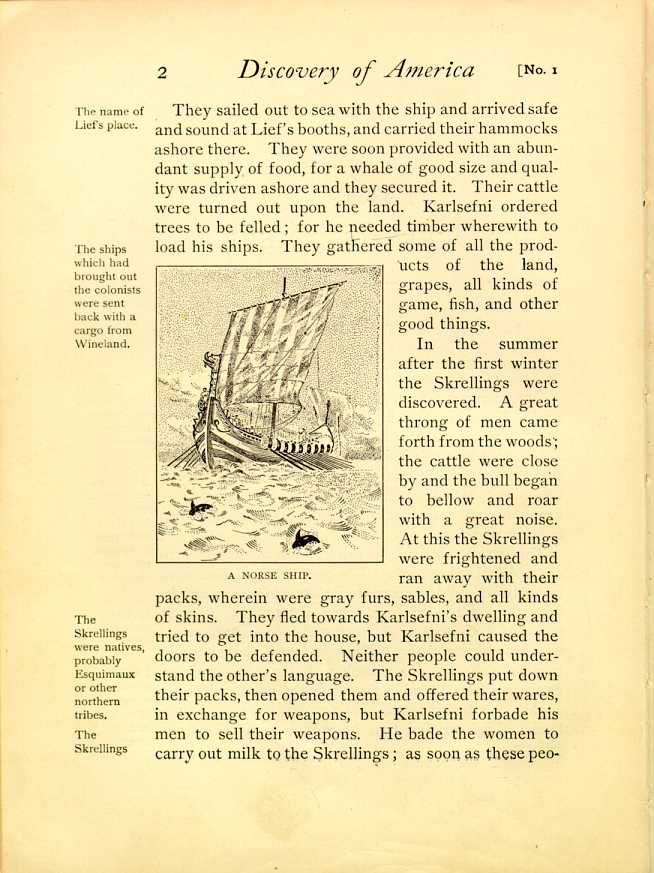
A NORSE SHIP.
[Description: Black and white illustration of a Norse ship at sea, with
dolphins in foreground.]
In the summer after the first winter the Skrellings were discovered.[6] A great throng of men came forth from the woods; the cattle were close by and the bull began to bellow and roar with a great noise. At this the Skrellings were frightened and ran away with their packs, wherein were gray furs, sables, and all kinds of skins. They fled towards Karlsefni's dwelling and tried to get into the house, but Karlsefni caused the doors to be defended. Neither people could understand the other's language. The Skrellings put down their packs, then opened them and offered their wares, in exchange for weapons, but Karlsefni forbade his men to sell their weapons. He bade the women to carry out milk to the Skrellings; as soon as these people
Now it is to be told that Karlsefni caused a strong wooden palisade to be constructed and set up around the house. It was at this time that a baby boy was born to Gudrid and Karlsefni and he was called Snorri.[8] In the early part of the second winter the Skrellings came to them again in greater numbers than before, and brought with them the same kind of wares to exchange. Then said Karlsefni to the women, "Do ye carry out now the same thing which proved so profitable before and nothing else." The Skrellings seemed contented at first, but soon after, while Gudrid was sitting in the doorway beside the cradle of her infant son, Snorri, she heard a great crash made by one of the Skrellings who had tried to seize a man's weapons. One of Karlsefni's followers killed him for it. "Now we must needs take counsel together," said Karlsefni, "for I believe they will visit us a third time in greater numbers. Let us now adopt this plan: when the tribe approaches from the forest, ten of our number shall go out upon the cape in front of our houses and show themselves there, while the remainder of our company shall go into the woods back of our houses and hew a clearing for our cattle. Then we will take our bull and let him go in advance of us to meet the enemy." The next time the Skrellings came they found Karlsefni's men ready and fled helter-skelter into the woods. Karlsefni and his party remained there throughout the winter, but in the spring Karlsefni announced that he did not intend to remain there longer, for he wished to return with his wife and son to Greenland. They now made ready for the voyage and carried away with them much in vines and grapes and skins.[9]
This story was handed down by tradition for many centuries; but it describes a real settlement, the first by Europeans in America nine centuries ago.
2. Throngs of Children to see Columbus[10]
BY CHRISTOPHER COLUMBUS (1492)
THIRTY-THREE days after my departure from Cadiz I reached the Indian Sea, where I discovered many islands which were thickly peopled. I took possession of these without resistance in the name of our most illustrious Monarch,[11] by a public proclamation and with unfurled banners. To the first of these islands, which is called by the Indians Guanahani, I gave the name of the blessed Saviour, San Salvador,[12] relying upon whose protection I had reached this as well as the other islands. As soon as we arrived at the great island, which I have said was named Juana,[13] I proceeded along its coast a short distance westward, and found it to be so large and apparently without termination, that I could not suppose it to be an island, but the continental province of Cathay.[14] In the meantime I had learned from some Indians whom I had seized, that that country was certainly an island: and therefore I sailed towards the east, coasting to the distance of three hundred and twenty-two miles, which brought us to the extremity of it. From this point I saw lying eastwards another island, fifty-four miles distant from Juana, to which I gave the name of Espanola.[15] All these islands are very beautiful; they are filled with a great variety of trees of immense height which retain their foliage in all seasons, I believe, for when I saw them they were as verdant and luxuriant as they usually are in Spain in the month of May.
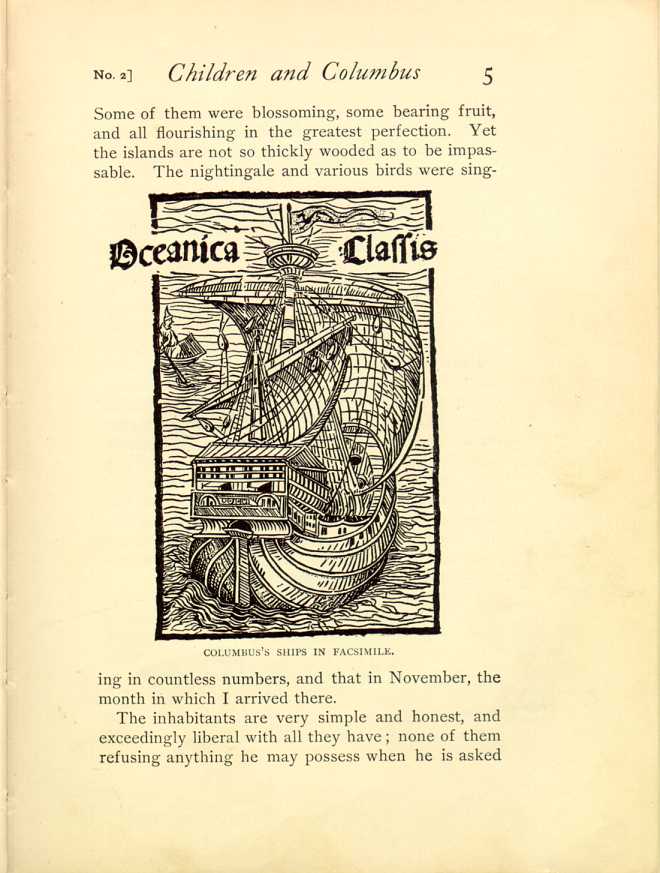
COLUMBUS'S SHIPS IN FACSIMILE.
[Description: Black and white illustration of a ship at sea, with the text Oceanica Classis (?) above it.]The inhabitants are very simple and honest, and exceedingly liberal with all they have; none of them refusing anything he may possess when he is asked
On my arrival in the new world I took some Indians by force from the first island to which I came, in order that they might learn our language. These men are still travelling with me, and although they have been with us now for a long time, they continue to entertain the idea that I have descended from heaven. On our arrival at any new place they publish this, crying out immediately with a loud voice to the other Indians, "Come, come and look upon beings of a celestial race": upon which both women and men, children and adults, young men and old, when they get rid of the fear they at first entertain, will come out in throngs, crowding the roads to see us, some bringing food and others drink, with astonishing affection and kindness.[16]
The friendly people were soon after made slaves by the Spaniards, and in a few years were almost all dead from the cruel treatment of their masters.
3. A Father dressed in Silk
BY TWO ITALIAN GENTLEMEN (1497)
LONDON, 23d August, 1497.
OUR Venetian, John Cabot, who went with a small ship from Bristol to find new islands, has come back, and says that he has discovered, seven hundred leagues off, the mainland of the country of China.[17] He coasted along it for three hundred leagues,[18] and landed but did not see any people. But he has brought here to the king certain snares spread to take game, and a needle for making nets. He found some notched trees, from which he judged that people lived about there. Being in doubt, he came back to the ship. He had been away three months on the voyage, and, in returning, he saw two islands to the right; but he did not wish to land, lest he should lose time, for he was in want of provisions. The king of this country has been much pleased.[19] He has promised for another time ten armed ships such as Cabot desires, and has given him all the prisoners, except such as are confined for high treason, to go with him.[20] The king has granted him money also, with which to amuse himself till then. Meanwhile, he is with his Venetian wife and his sons at Bristol. His name is John Cabot and he is called the Great Admiral; great honor is paid to him, and he goes about dressed in silk. The English are ready to go with him, and so are many of our rascals.[21] As discoverer of these things, Cabot has planted a large cross in the ground with a banner of England, and one of St. Mark, as he is a Venetian;[22] so that our flag has been hoisted very far away.
18th December, 1497.
Perhaps amidst so many occupations of your Excellency it will not be unwelcome to learn how the King of England has gained a part of Asia without drawing his sword.[23] In this kingdom there is a certain Venetian named John Cabot, of gentle disposition, very expert in navigation, who, seeing that the most serene Kings of Portugal and Spain had occupied unknown islands, wished to gain new territory for the English king. Having obtained the king's promise that he might have the lordship of the dominions which he might discover, Cabot embarked in a small vessel with a crew of eighteen persons, and set out from Bristol, a port in the western part of this kingdom. He wandered for a long time; at length he came to land, where he hoisted the royal standard, and took possession for his Highness; then, having obtained various proofs of his discovery, he returned.
Since John was a foreigner and poor, he would not have been believed if the crew, who are nearly all English, and belong to Bristol, had not testified that what he said was the truth. This Cabot has the description of the world on a chart, and also on a solid sphere which he has made. On this he shows where he has been. They say that the new land is excellent and the climate is temperate; they also say that perhaps dye-wood and silk grow there. They affirm that the sea is full of fish which are taken not only with a net, but also with a basket, which has a stone fastened to it in order to keep it in the water. This I have heard John Cabot himself say. People look upon him as a prince.[24]
John Cabot was sent out by Henry VII, King of England, and this was the first English voyage to America.
4. The Name America[25]
BY HYLACOMYLUS (1507)
AND the fourth part of the world having been discovered by Americus, it may be called Amerige; that is, the land of Americus or America.
Now truly, since these regions are more widely explored, and another fourth part is discovered by Americus Vesputius, as may be learned from the following letters, I do not see why any one may justly forbid it to be named Amerige, that is, Americ's Land, after Americus the discoverer, who is a man of sagacious mind; or call it America, since both Europa and Asia derived their names from women.
The first man to suggest the name of America was a German schoolmaster whose name means "Miller of the Wood Pond." Really Americus Vespucius discovered very little, and does not deserve to have the continents named for him.
5. How to find an Ocean
BY ANTONIO HERRERA (1513)
BALBOA, having resolved to march over to the South Sea, and having provided all things necessary for it, set out from Darien in the beginning of September, 1513.[26] He went by sea as far as the land of the Cacique Careta. There he left the brigantines and the canoes and advanced towards the mountain. Careta who was friendly to him commanded some of his subjects to attend Balboa. A neighboring Cacique, Ponca, by name, who had spies abroad, was informed that the Spaniards were coming up his mountain, and hid himself in an out of the way part of his territory. Balboa sent some of the Careta Indians to assure him that he was doing no harm but would be his friend as he was Careta's. So Ponca came, bringing a present of gold.
Then Balboa proceeded to the top of the mountain whence he had been told that the other sea might be seen. From Ponca's land to the top was about six days' journey; but they spent twenty-five days because of the roughness of the land, and because they were short of provisions. At length they arrived at the top of the high mountain, on the twenty-fifth of September, 1513 , whence the sea could be seen. Balboa was given notice a little while before they came to the top that they were very near it. Commanding all to halt there, Balboa went up alone and saw the South Sea; then, with uplifted hands and on his knees, he returned thanks to heaven for being the first who had seen this sea.
After performing this act of devotion he called his men and repeated the same, and they followed his example, while the Indians stood amazed to see them so overjoyed. Balboa praised Camegra's son for giving him this news, and promised all his followers much wealth and happiness. They all believed him, for he was very much beloved because he made no difference between himself and the common soldiers, He always showed sympathy for the sick and wounded, every one of whom he visited and comforted. He was himself undaunted in dangers, never showing the least fear in the greatest perils.
Balboa next ordered that a certificate should be drawn of his taking possession of that sea and all
Alonzo Martin hit upon the shortest road and in two days came to a place where he found two canoes upon dry land, yet saw no sea; but whilst he was considering how those canoes were up on the land, the sea water came in and lifted them up about a fathom in height;[30] for upon that coast the sea ebbs and flows every six hours, two or three fathoms, so that great ships are left dry and no sea water appears for half a league at least. Alonzo Martin, seeing the canoes begin to swim, went into one of them and bid his companions to bear witness that he was the first to enter the South Sea. Another man whose name was Atienza did the like and bid them bear witness that he was the second. They returned to Balboa with the news, which made them all rejoice.[31]
The South Sea, which we call the Pacific Ocean, which washed the eastern shores of India and China, was what most of the early European Explorers set out to find. Balboa, a Spanish officer, had heard from a native chief that there was a great sea across the mountains.
Nobody then guessed that there was an opening south of the land, by which they could sail into the Pacific Ocean.
6. A Room Full of Gold
BY FRANCISCO XERES (1533)
GOVERNOR PIZARRO received news from the natives that the way to Cuzco passed through very populous districts which were rich and fertile;[32] that there was an inhabited valley called Caxamalca ten or twelve
The Governor departed from the city of San Miguel in search of Atahuallpa on the twenty-fourth of September, 1532.[34] He arrived at the town of Caxamalca two months later at the hour of vespers. In the middle of the town there was a great open space surrounded by walls and houses. The Governor occupied this position and sent a messenger to Atahuallpa to announce his arrival, to arrange a meeting, and in order that he might show him where to lodge; meanwhile he ordered the town to be examined with a view to discovering a strong position where he might pitch his camp. He ordered all the troops to be stationed in the open space and the cavalry to remain mounted until it was seen whether Atahuallpa would come.
This town, which is the principal place in the valley, is situated on the edge of a mountain, with an open plain in front of it. Two rivers flow through the valley, which is level and well peopled with
Atahuallapa feared that the Spaniards would kill him, so he told Governor Pizarro that he would give his captors a great quantity of gold and silver.[37] The Governor asked him: "How much can you give and in what time ?" Atahuallapa said: "I will give gold enough to fill a room twenty-two feet long and seventeen wide up to a white line which is half way up the wall. The height will be once and a half that of a man's stature." Atahuallapa also said, that up to that mark he would fill the room with different kinds of golden vessels, such as jars, pots, vases, besides lumps and other pieces. As for silver, he said that he would fill a whole chamber with it twice over. He undertook to do this in two months. Governor Pizarro told him to send off messengers for this purpose, and that when it was accomplished he need have no fear.
Then Atahuallapa sent messages to his captains who were in the city of Cuzco, ordering them to send two thousand Indians, laden with gold and silver. After
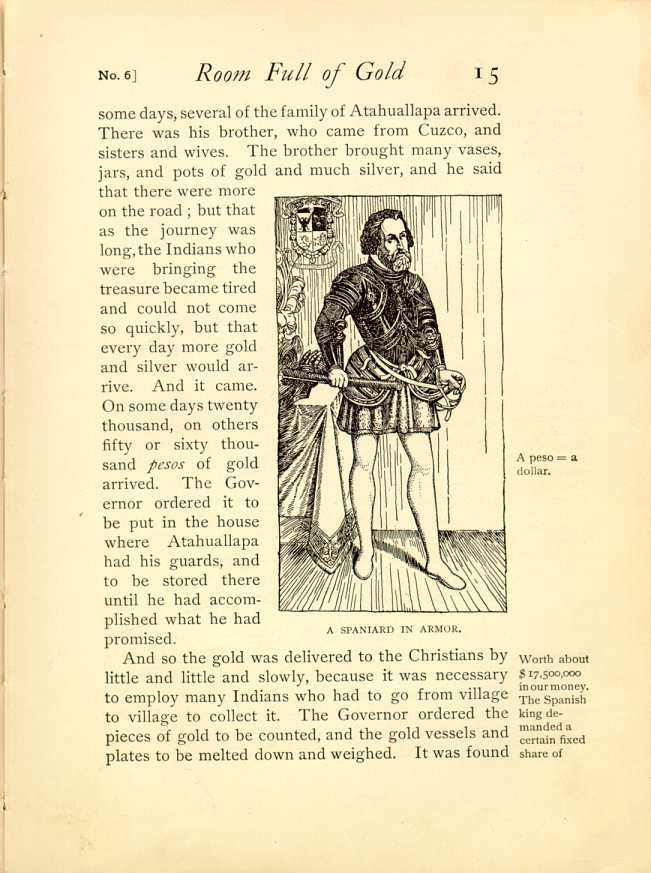
SPANIARD IN ARMOR.
[Description: Black and white illustration of a man with upper-body armor, with hand on sword.]And so the gold was delivered to the Christians by little and little and slowly, because it was necessary to employ many Indians who had to go from village to village to collect it.[39] The Governor ordered the pieces of gold to be counted, and the gold vessels and plates to be melted down and weighed. It was found
Pizarro was a Spanish officer who had got permission from Spain to conquer the region in South America which we call Peru. Cuzco was the native capital.
A great battle between Atahuallapa's forces and Pizarro's took place, in which Atahuallapa was taken prisoner. Throughout his captivity he was kindly treated, but he felt uneasy about his safety.
Worth about $17,500,000 in our money. The Spanish king demanded a certain fixed share of treasures found in the new world.
7. Buried in the Mississippi
BY A PORTUGUESE GENTLEMAN OF ELVAS (1542)
CAPTAIN DE SOTO was the son of a Spanish squire. He went into the Spanish Indies when Peter Arias was governor of the West Indies.[41] There he was without anything of his own save his sword and shield. For his good qualities and valor, Peter Arias made him captain of a troop of horsemen, and by his own command De Soto went with Fernando Pizarro to the conquest of Peru. Afterwards the Spanish Emperor made him governor of the Isle of Cuba and President of Florida, with the title of Marquis over a certain part of the lands which he might conquer.
On Sunday, the eighteenth day of May, in the year 1539, President De Soto departed from Havana in Cuba with his fleet, which consisted of nine vessels, five great ships, two caravels and two brigantines.[42] They sailed for seven days with a prosperous wind. On Friday they landed on the western coast of Florida.
De Soto left Captain Caldero there with thirty horsemen and seventy footmen with provisions for
After many weary and dangerous marches, the governor fell into great dumps to see how hard it was to get down the Mississippi to the sea. It seemed even worse, because the number of his men and horses was every day diminished, as they could not find enough food to sustain them in this country. Discouraged by that thought De Soto fell sick. Before he took his bed, he sent an Indian to the cacique at Quigalta to tell him that he, Fernando De Soto, was the Child of the Sun, and that all the way on his journey thither, all men had obeyed and served him; that he requested him to accept of his friendship, and come to him, for he should be very glad to see him; and in sign of love and obedience to bring something with him of that which in his country was most prized. The cacique answered by the same Indian, saying that whereas De Soto said that he was the Child of the Sun, if he would dry up the Great River he would believe him; and touching the rest, that he was wont to visit none; but rather that all those of whom he had notice did visit him, served, obeyed, and paid him tributes willingly or perforce. Therefore, if De Soto desired to see him, it were best he should come to his place. That if he came in peace, he would receive him with special good will. Or if De Soto came in war, even then the chief told him to come and find the Indians in the town where, they were, adding, that for De Soto or any other person he would not shrink one foot back.
By the time the Indian returned with this answer, the governor had betaken himself to bed, very ill with fever and much grieved that he was not able to pass over the river and seek this cacique to see if he could lessen that pride of his. But the current of the river was very strong in those parts, where it was nearly half a league broad and sixteen fathoms deep.[43] On both sides there were many Indians, and his power was not now so great but that he had need to help himself when he could by flight rather than by force.
Before he could do either, on the twenty-first of May, in the year 1542, Don Fernando De Soto, the valorous, virtuous, and valiant captain, Governor of Cuba, and President of Florida, departed out of this life. He departed in such a place and at such a time that during his sickness he had had but little comfort, and the danger wherein all his people found themselves of perishing in that strange country, is the reason why they did not visit nor stay with him as they ought to have done.
Luys de Moscoso[44] determined to conceal this death from the Indians because Fernando De Soto had made them believe that the Christians were immortal; and, since they had considered him to be hardy, wise, and valiant, Moscoso feared that if they should know that he was dead they would be bold to set upon the Christians, even if the Spaniards tried to live peaceably among them.
As soon as De Soto was dead, therefore, Luys de Moscoso commanded the men to put him in a house secretly. Here he remained for three days. Removing him thence, Moscoso commanded them to bury him in the night at one of the gates of the town
The cacique of Guachaya inquired for him, demanding what was become of his brother, the governor. Luys de Moscoso told him that he had gone to heaven as he had many other times, and because he was to stay there certain days, he had left him in his place.
The cacique still thought that the governor was dead, and commanded two young and well proportioned Indians to be brought thither, praying Luys to command them to be beheaded that they might attend and serve his lord and brother after his death. Luys told him that the governor was not dead but had gone to heaven and that he had taken such of his own Christian soldiers as he needed away with him; but the Indians believed nothing of what he said.[45]
This is one of the unsuccessful expeditions made by the Spaniards. De Soto expected to find gold as Pizarro had done.
A small remnant of the proud expedition, at last escaped to the sea. Neither De Soto's pride nor Moscoso's lies helped them.
8. Esquimaux Foot-ball
BY RICHARD HAKLUYT (ABOUT 1590)
I FIND that in the manner of living the people of the northeast and
those of the northwest are alike.[46] They
have an olive complexion, are very active and nimble men, and are a
strong, warlike people; for even in our sight on the tops of the hills
they
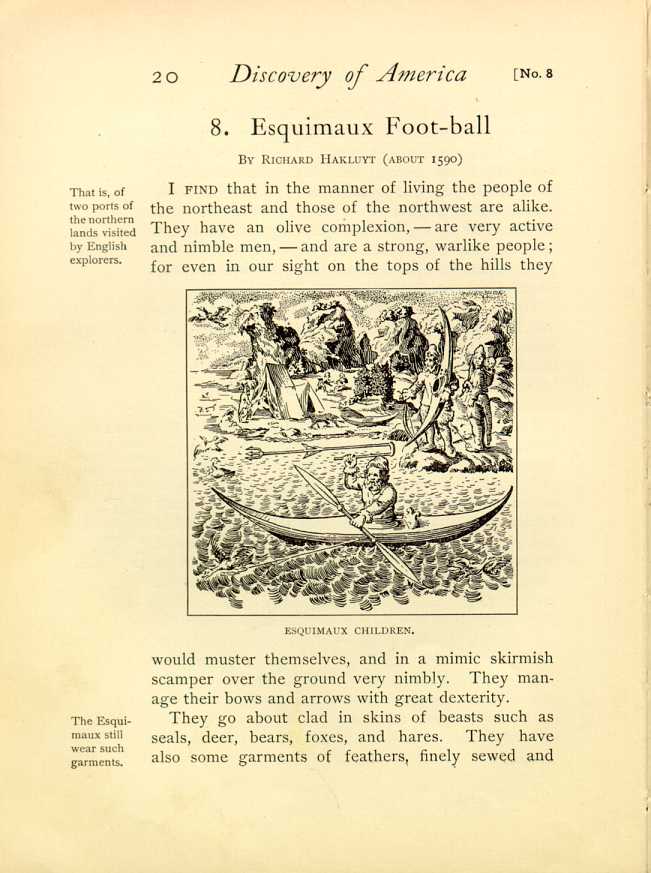
ESQUIMAUX CHILDREN.
[Description: Black and white illustration of a man in a canoe with a
hunting spear or harpoon; in the background a man and a woman with a
child on her back look on.]
They go about clad in skins of beasts such as seals, deer, bears, foxes, and hares.[47] They have also some garments of feathers, finely sewed and
These people are by nature subtle and sharp-witted, ready to understand our meaning by signs and make answers that can be well understood. If they have not seen the thing whereof we ask, they will wink or cover their eyes with their hands as if to say it had been hid from sight. If they do not understand what you ask them, they will stop their ears. They are willing to teach us the names of anything in their language which we desire to know, and are quick to learn anything of us. They delight in music and will keep time and stroke to any tune which we may sing, both with their voice, head, hands, and feet, and will sing the same tune after us.
They live in caves in the earth and hunt for their dinners just as the bears and other wild beasts do. They eat raw flesh and fish.
On the twenty-first of August the captain of our ship sent a boat on shore for wood with six of our men who had friendly dealings with these Esquimaux. After that, they beckoned us on shore several times to play foot-ball with them, and some of our company went on shore to play with them; but nimble as they were, as often as they struck at the ball our men won the game.
| Colonial Children | ||
